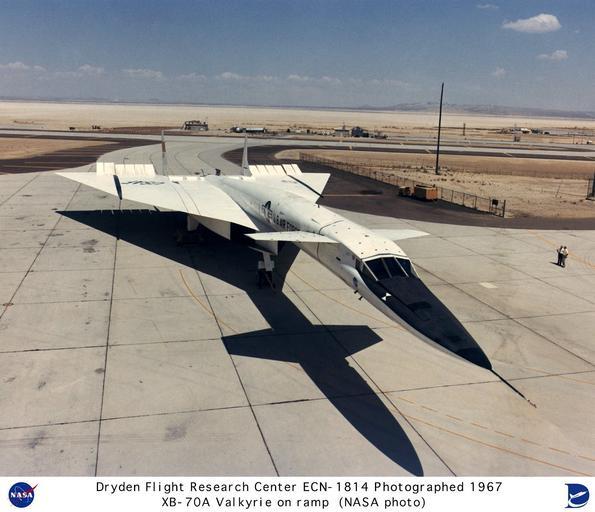MAKE A MEME
View Large Image

| View Original: | XB-70A_parked_on_ramp_DVIDS709611.jpg (1536x1321) | |||
| Download: | Original | Medium | Small | Thumb |
| Courtesy of: | commons.wikimedia.org | More Like This | ||
| Keywords: XB-70A parked on ramp DVIDS709611.jpg en This photo shows the XB-70A parked on a ramp at Edwards Air Force Base in 1967 Originally designed as a Mach 3 bomber the XB-70A never went into production and instead was used for flight research involving the Air Force and NASA's Flight Research Center FRC which was a predecessor of today's NASA Dryden Flight Research Center The aircraft's shadow indicates its unusual planform This featured two canards behind the cockpit followed by a large triangular delta wing The outboard portions of the wing were hinged so they could be folded down for improved high-speed stability The XB-70 was the world's largest experimental aircraft It was capable of flight at speeds of three times the speed of sound roughly 2 000 miles per hour at altitudes of 70 000 feet It was used to collect in-flight information for use in the design of future supersonic aircraft military and civilian The major objectives of the XB-70 flight research program were to study the airplane's stability and handling characteristics to evaluate its response to atmospheric turbulence and to determine the aerodynamic and propulsion performance In addition there were secondary objectives to measure the noise and friction associated with airflow over the airplane and to determine the levels and extent of the engine noise during takeoff landing and ground operations The XB-70 was about 186 feet long 33 feet high with a wingspan of 105 feet Originally conceived as an advanced bomber for the United States Air Force the XB-70 was limited to production of two aircraft when it was decided to limit the aircraft's mission to flight research The first flight of the XB-70 was made on Sept 21 1964 The number two XB-70 was destroyed in a mid-air collision on June 8 1966 Program management of the NASA-USAF research effort was assigned to NASA in March 1967 The final flight was flown on Feb 4 1969 Designed by North American Aviation later North American Rockwell and still later a division of Boeing the XB-70 had a long fuselage with a canard or horizontal stabilizer mounted just behind the crew compartment It had a sharply swept 65 6-percent delta wing The outer portion of the wing could be folded down in flight to provide greater lateral-directional stability The airplane had two windshields A moveable outer windshield was raised for high-speed flight to reduce drag and lowered for greater visibility during takeoff and landing The forward fuselage was constructed of riveted titanium frames and skin The remainder of the airplane was constructed almost entirely of stainless steel The skin was a brazed stainless-steel honeycomb material Six General Electric YJ93-3 turbojet engines each in the 30 000-pound-thrust class powered the XB-70 Internal geometry of the inlets was controllable to maintain the most efficient airflow to the engines NASA Identifier NIX-ECN-1814 2009-09-23 Glenn Research Center https //www dvidshub net/image/709611 709611 2012-10-10 16 39 WASHINGTON DC US PD-USGov Aircraft at Edwards Air Force Base Images from DoD uploaded by Fæ North American XB-70 | ||||